M&S Ltd: Applying Leadership and Management Theories and Models
VerifiedAdded on 2024/06/07
|26
|5233
|212
Report
AI Summary
This report provides a comprehensive analysis of management and operations within M&S Ltd., focusing on the roles and functions of leaders and managers. It defines and compares the characteristics of leaders and managers, highlighting their distinct approaches and responsibilities. The report applies various leadership theories such as action-oriented, transformational, contingency, and trait theories, alongside management theories like classical, behavioral, and management by objectives. It examines how these theories are applied in different situational contexts within M&S Ltd., such as employee retention and productivity improvement. Furthermore, it assesses the strengths and weaknesses of different approaches to leadership, including situational leadership, system leadership, and contingency leadership, providing a detailed understanding of their impact on the work environment and organizational effectiveness. Desklib offers students access to a wealth of similar solved assignments and past papers to aid in their studies.
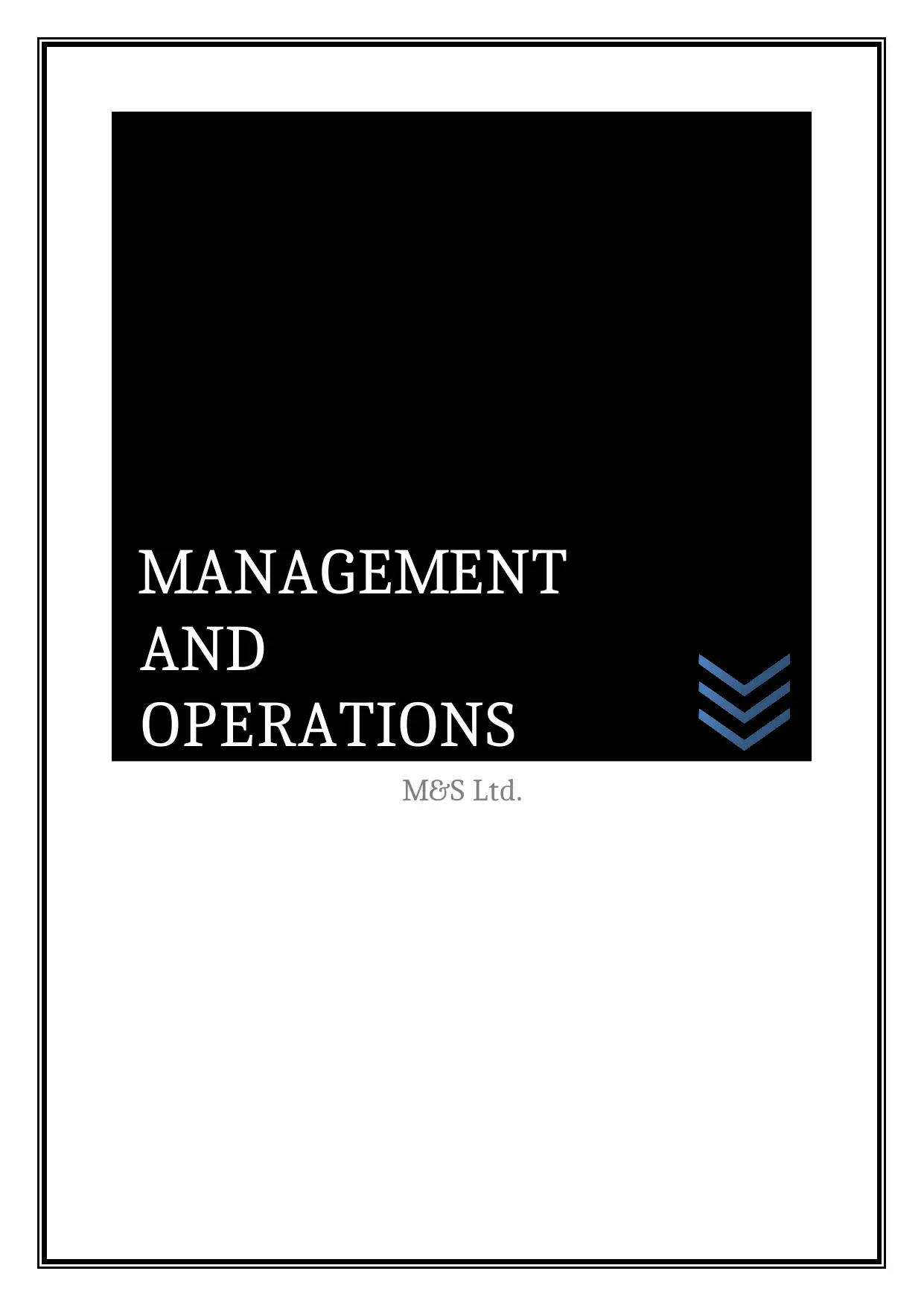
M&S Ltd.
MANAGEMENT
AND
OPERATIONS
MANAGEMENT
AND
OPERATIONS
Paraphrase This Document
Need a fresh take? Get an instant paraphrase of this document with our AI Paraphraser

2
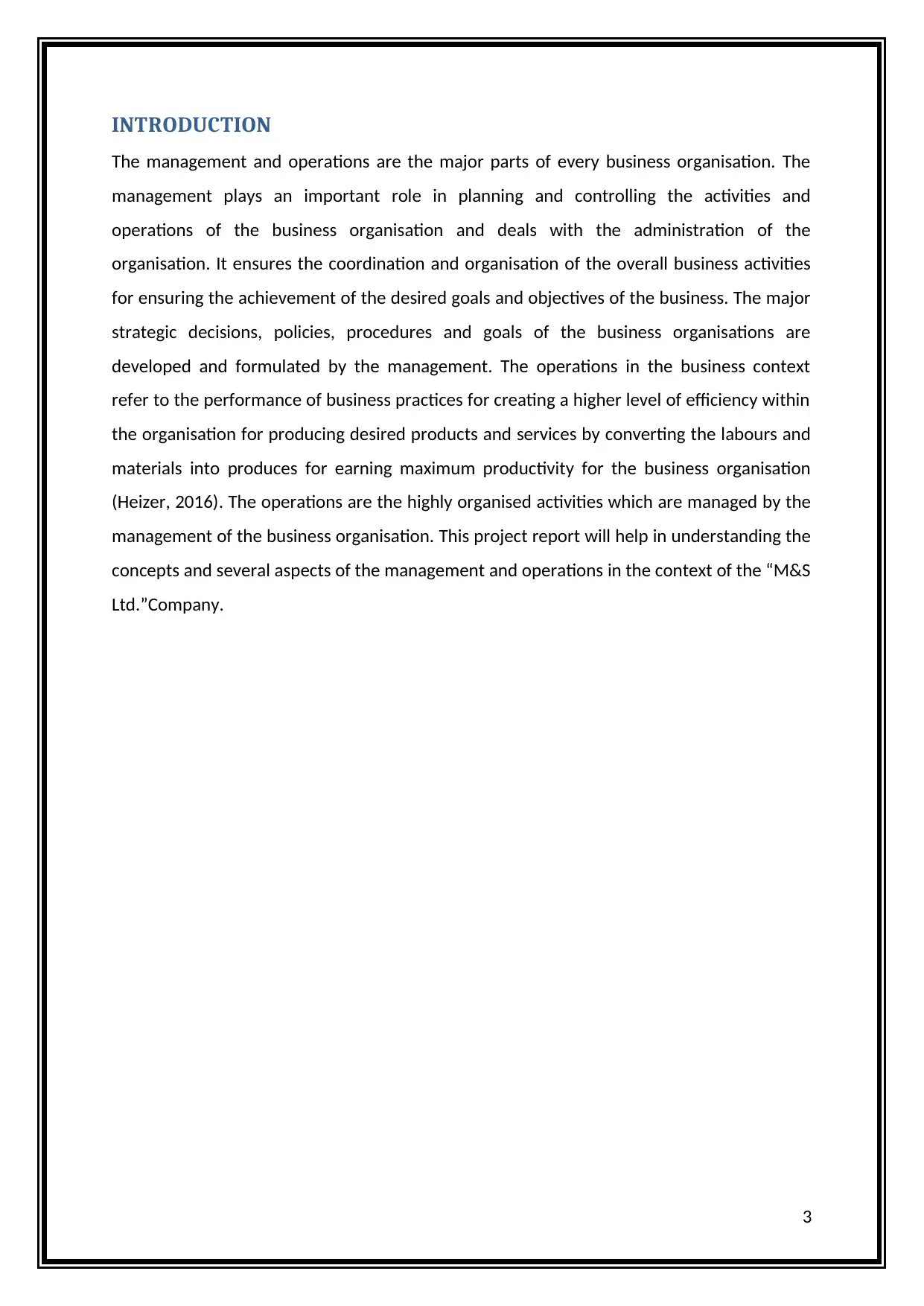
INTRODUCTION
The management and operations are the major parts of every business organisation. The
management plays an important role in planning and controlling the activities and
operations of the business organisation and deals with the administration of the
organisation. It ensures the coordination and organisation of the overall business activities
for ensuring the achievement of the desired goals and objectives of the business. The major
strategic decisions, policies, procedures and goals of the business organisations are
developed and formulated by the management. The operations in the business context
refer to the performance of business practices for creating a higher level of efficiency within
the organisation for producing desired products and services by converting the labours and
materials into produces for earning maximum productivity for the business organisation
(Heizer, 2016). The operations are the highly organised activities which are managed by the
management of the business organisation. This project report will help in understanding the
concepts and several aspects of the management and operations in the context of the “M&S
Ltd.”Company.
3
The management and operations are the major parts of every business organisation. The
management plays an important role in planning and controlling the activities and
operations of the business organisation and deals with the administration of the
organisation. It ensures the coordination and organisation of the overall business activities
for ensuring the achievement of the desired goals and objectives of the business. The major
strategic decisions, policies, procedures and goals of the business organisations are
developed and formulated by the management. The operations in the business context
refer to the performance of business practices for creating a higher level of efficiency within
the organisation for producing desired products and services by converting the labours and
materials into produces for earning maximum productivity for the business organisation
(Heizer, 2016). The operations are the highly organised activities which are managed by the
management of the business organisation. This project report will help in understanding the
concepts and several aspects of the management and operations in the context of the “M&S
Ltd.”Company.
3
⊘ This is a preview!⊘
Do you want full access?
Subscribe today to unlock all pages.

Trusted by 1+ million students worldwide

TASK 1
INTRODUCTION-
The success of every organisation depends on the roles and functions performed by the
managers and leaders of the organisations. In this report, as a management consultant of M
& S Ltd., I have clearly described the different roles and functions of managers and leaders
of the organisation and also discussed several approaches and models of leadership and
management that could be applied by them in different organisational situations.
P1 DEFINE AND COMPARE DIFFERENT ROLES AND CHARACTERISTICS OF
LEADER AND A MANAGER
Leader
In simple words, a leader could be defined as a person who commands or leads a particular
team, group, organisation or a nation. In other words, a leader is a person who holds a
superior or a dominant position within the particular field of the organisation for exercising
a high degree of control on, and for influencing subordinates or other persons. The leader
leads the group of people and is responsible for motivating and encouraging the team or a
group towards the achievement of the desired goals and objectives (Spears, 2010). It is
essentials for the leaders to create a positive environment to encourage every group
member to perform their roles more enthusiastically and responsible for contributing to the
common objectives of the organisation.
Manager
A manager is a person who is responsible for administering and controlling a particular
organisation or a group. The manager is responsible for planning and managing the flow of
work within an organisation by fulfilling all the requirements and assuring the optimum
availability of the resources for accomplishing the pre-determined goals and objectives of
the organisation. In simple words, managers are the individuals who are responsible for
performing major functions within an organisation such as planning, organising, directing,
coordinating and controlling of all the organisational activities and tasks (Mahmood, et al.,
2012). Every business organisation has several types of managers such as top-level
4
INTRODUCTION-
The success of every organisation depends on the roles and functions performed by the
managers and leaders of the organisations. In this report, as a management consultant of M
& S Ltd., I have clearly described the different roles and functions of managers and leaders
of the organisation and also discussed several approaches and models of leadership and
management that could be applied by them in different organisational situations.
P1 DEFINE AND COMPARE DIFFERENT ROLES AND CHARACTERISTICS OF
LEADER AND A MANAGER
Leader
In simple words, a leader could be defined as a person who commands or leads a particular
team, group, organisation or a nation. In other words, a leader is a person who holds a
superior or a dominant position within the particular field of the organisation for exercising
a high degree of control on, and for influencing subordinates or other persons. The leader
leads the group of people and is responsible for motivating and encouraging the team or a
group towards the achievement of the desired goals and objectives (Spears, 2010). It is
essentials for the leaders to create a positive environment to encourage every group
member to perform their roles more enthusiastically and responsible for contributing to the
common objectives of the organisation.
Manager
A manager is a person who is responsible for administering and controlling a particular
organisation or a group. The manager is responsible for planning and managing the flow of
work within an organisation by fulfilling all the requirements and assuring the optimum
availability of the resources for accomplishing the pre-determined goals and objectives of
the organisation. In simple words, managers are the individuals who are responsible for
performing major functions within an organisation such as planning, organising, directing,
coordinating and controlling of all the organisational activities and tasks (Mahmood, et al.,
2012). Every business organisation has several types of managers such as top-level
4
Paraphrase This Document
Need a fresh take? Get an instant paraphrase of this document with our AI Paraphraser
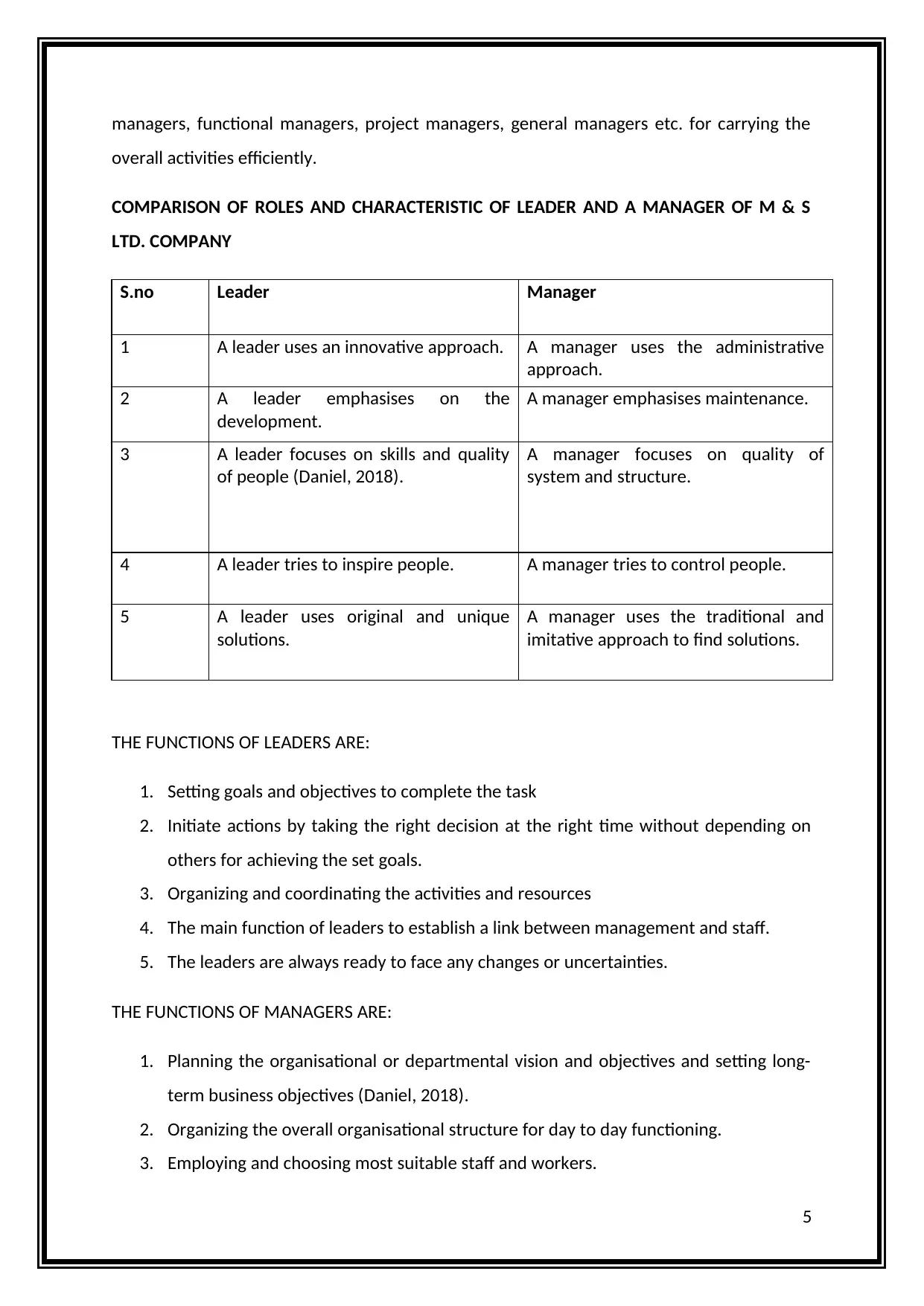
managers, functional managers, project managers, general managers etc. for carrying the
overall activities efficiently.
COMPARISON OF ROLES AND CHARACTERISTIC OF LEADER AND A MANAGER OF M & S
LTD. COMPANY
S.no Leader Manager
1 A leader uses an innovative approach. A manager uses the administrative
approach.
2 A leader emphasises on the
development.
A manager emphasises maintenance.
3 A leader focuses on skills and quality
of people (Daniel, 2018).
A manager focuses on quality of
system and structure.
4 A leader tries to inspire people. A manager tries to control people.
5 A leader uses original and unique
solutions.
A manager uses the traditional and
imitative approach to find solutions.
THE FUNCTIONS OF LEADERS ARE:
1. Setting goals and objectives to complete the task
2. Initiate actions by taking the right decision at the right time without depending on
others for achieving the set goals.
3. Organizing and coordinating the activities and resources
4. The main function of leaders to establish a link between management and staff.
5. The leaders are always ready to face any changes or uncertainties.
THE FUNCTIONS OF MANAGERS ARE:
1. Planning the organisational or departmental vision and objectives and setting long-
term business objectives (Daniel, 2018).
2. Organizing the overall organisational structure for day to day functioning.
3. Employing and choosing most suitable staff and workers.
5
overall activities efficiently.
COMPARISON OF ROLES AND CHARACTERISTIC OF LEADER AND A MANAGER OF M & S
LTD. COMPANY
S.no Leader Manager
1 A leader uses an innovative approach. A manager uses the administrative
approach.
2 A leader emphasises on the
development.
A manager emphasises maintenance.
3 A leader focuses on skills and quality
of people (Daniel, 2018).
A manager focuses on quality of
system and structure.
4 A leader tries to inspire people. A manager tries to control people.
5 A leader uses original and unique
solutions.
A manager uses the traditional and
imitative approach to find solutions.
THE FUNCTIONS OF LEADERS ARE:
1. Setting goals and objectives to complete the task
2. Initiate actions by taking the right decision at the right time without depending on
others for achieving the set goals.
3. Organizing and coordinating the activities and resources
4. The main function of leaders to establish a link between management and staff.
5. The leaders are always ready to face any changes or uncertainties.
THE FUNCTIONS OF MANAGERS ARE:
1. Planning the organisational or departmental vision and objectives and setting long-
term business objectives (Daniel, 2018).
2. Organizing the overall organisational structure for day to day functioning.
3. Employing and choosing most suitable staff and workers.
5

4. Provides direction of work to the employees.
5. Controlling and monitoring the functional activities.
6
5. Controlling and monitoring the functional activities.
6
⊘ This is a preview!⊘
Do you want full access?
Subscribe today to unlock all pages.

Trusted by 1+ million students worldwide
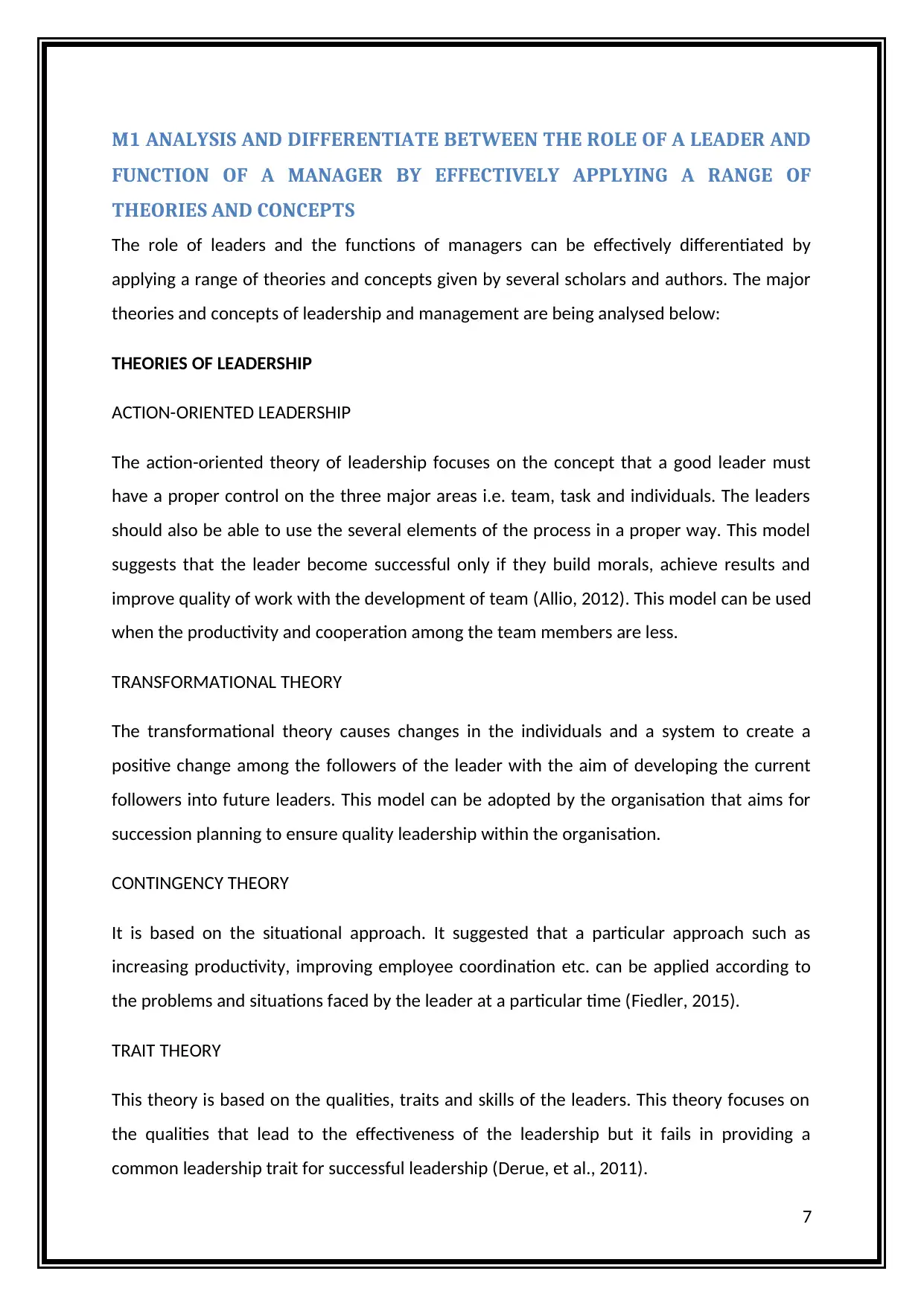
M1 ANALYSIS AND DIFFERENTIATE BETWEEN THE ROLE OF A LEADER AND
FUNCTION OF A MANAGER BY EFFECTIVELY APPLYING A RANGE OF
THEORIES AND CONCEPTS
The role of leaders and the functions of managers can be effectively differentiated by
applying a range of theories and concepts given by several scholars and authors. The major
theories and concepts of leadership and management are being analysed below:
THEORIES OF LEADERSHIP
ACTION-ORIENTED LEADERSHIP
The action-oriented theory of leadership focuses on the concept that a good leader must
have a proper control on the three major areas i.e. team, task and individuals. The leaders
should also be able to use the several elements of the process in a proper way. This model
suggests that the leader become successful only if they build morals, achieve results and
improve quality of work with the development of team (Allio, 2012). This model can be used
when the productivity and cooperation among the team members are less.
TRANSFORMATIONAL THEORY
The transformational theory causes changes in the individuals and a system to create a
positive change among the followers of the leader with the aim of developing the current
followers into future leaders. This model can be adopted by the organisation that aims for
succession planning to ensure quality leadership within the organisation.
CONTINGENCY THEORY
It is based on the situational approach. It suggested that a particular approach such as
increasing productivity, improving employee coordination etc. can be applied according to
the problems and situations faced by the leader at a particular time (Fiedler, 2015).
TRAIT THEORY
This theory is based on the qualities, traits and skills of the leaders. This theory focuses on
the qualities that lead to the effectiveness of the leadership but it fails in providing a
common leadership trait for successful leadership (Derue, et al., 2011).
7
FUNCTION OF A MANAGER BY EFFECTIVELY APPLYING A RANGE OF
THEORIES AND CONCEPTS
The role of leaders and the functions of managers can be effectively differentiated by
applying a range of theories and concepts given by several scholars and authors. The major
theories and concepts of leadership and management are being analysed below:
THEORIES OF LEADERSHIP
ACTION-ORIENTED LEADERSHIP
The action-oriented theory of leadership focuses on the concept that a good leader must
have a proper control on the three major areas i.e. team, task and individuals. The leaders
should also be able to use the several elements of the process in a proper way. This model
suggests that the leader become successful only if they build morals, achieve results and
improve quality of work with the development of team (Allio, 2012). This model can be used
when the productivity and cooperation among the team members are less.
TRANSFORMATIONAL THEORY
The transformational theory causes changes in the individuals and a system to create a
positive change among the followers of the leader with the aim of developing the current
followers into future leaders. This model can be adopted by the organisation that aims for
succession planning to ensure quality leadership within the organisation.
CONTINGENCY THEORY
It is based on the situational approach. It suggested that a particular approach such as
increasing productivity, improving employee coordination etc. can be applied according to
the problems and situations faced by the leader at a particular time (Fiedler, 2015).
TRAIT THEORY
This theory is based on the qualities, traits and skills of the leaders. This theory focuses on
the qualities that lead to the effectiveness of the leadership but it fails in providing a
common leadership trait for successful leadership (Derue, et al., 2011).
7
Paraphrase This Document
Need a fresh take? Get an instant paraphrase of this document with our AI Paraphraser
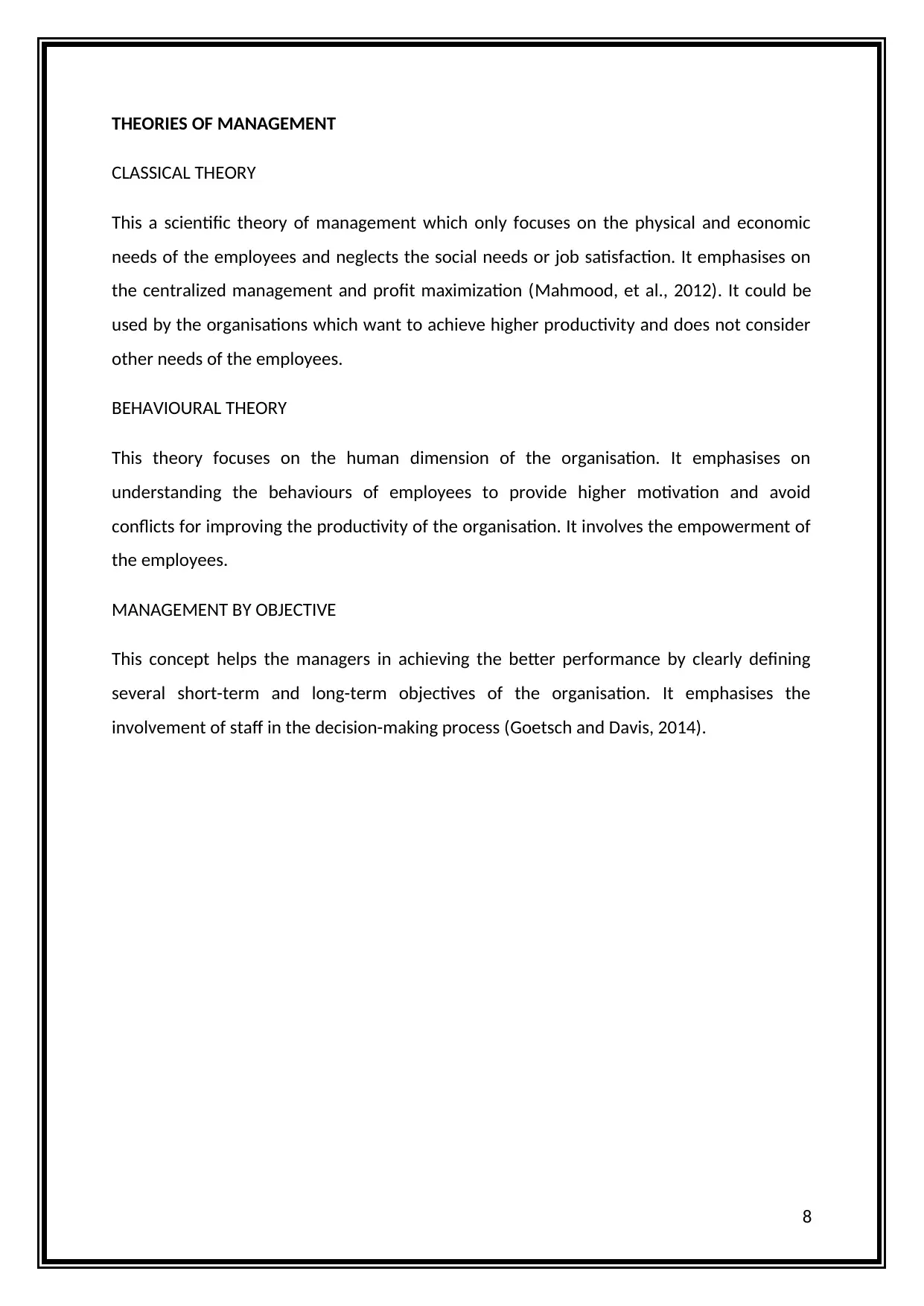
THEORIES OF MANAGEMENT
CLASSICAL THEORY
This a scientific theory of management which only focuses on the physical and economic
needs of the employees and neglects the social needs or job satisfaction. It emphasises on
the centralized management and profit maximization (Mahmood, et al., 2012). It could be
used by the organisations which want to achieve higher productivity and does not consider
other needs of the employees.
BEHAVIOURAL THEORY
This theory focuses on the human dimension of the organisation. It emphasises on
understanding the behaviours of employees to provide higher motivation and avoid
conflicts for improving the productivity of the organisation. It involves the empowerment of
the employees.
MANAGEMENT BY OBJECTIVE
This concept helps the managers in achieving the better performance by clearly defining
several short-term and long-term objectives of the organisation. It emphasises the
involvement of staff in the decision-making process (Goetsch and Davis, 2014).
8
CLASSICAL THEORY
This a scientific theory of management which only focuses on the physical and economic
needs of the employees and neglects the social needs or job satisfaction. It emphasises on
the centralized management and profit maximization (Mahmood, et al., 2012). It could be
used by the organisations which want to achieve higher productivity and does not consider
other needs of the employees.
BEHAVIOURAL THEORY
This theory focuses on the human dimension of the organisation. It emphasises on
understanding the behaviours of employees to provide higher motivation and avoid
conflicts for improving the productivity of the organisation. It involves the empowerment of
the employees.
MANAGEMENT BY OBJECTIVE
This concept helps the managers in achieving the better performance by clearly defining
several short-term and long-term objectives of the organisation. It emphasises the
involvement of staff in the decision-making process (Goetsch and Davis, 2014).
8
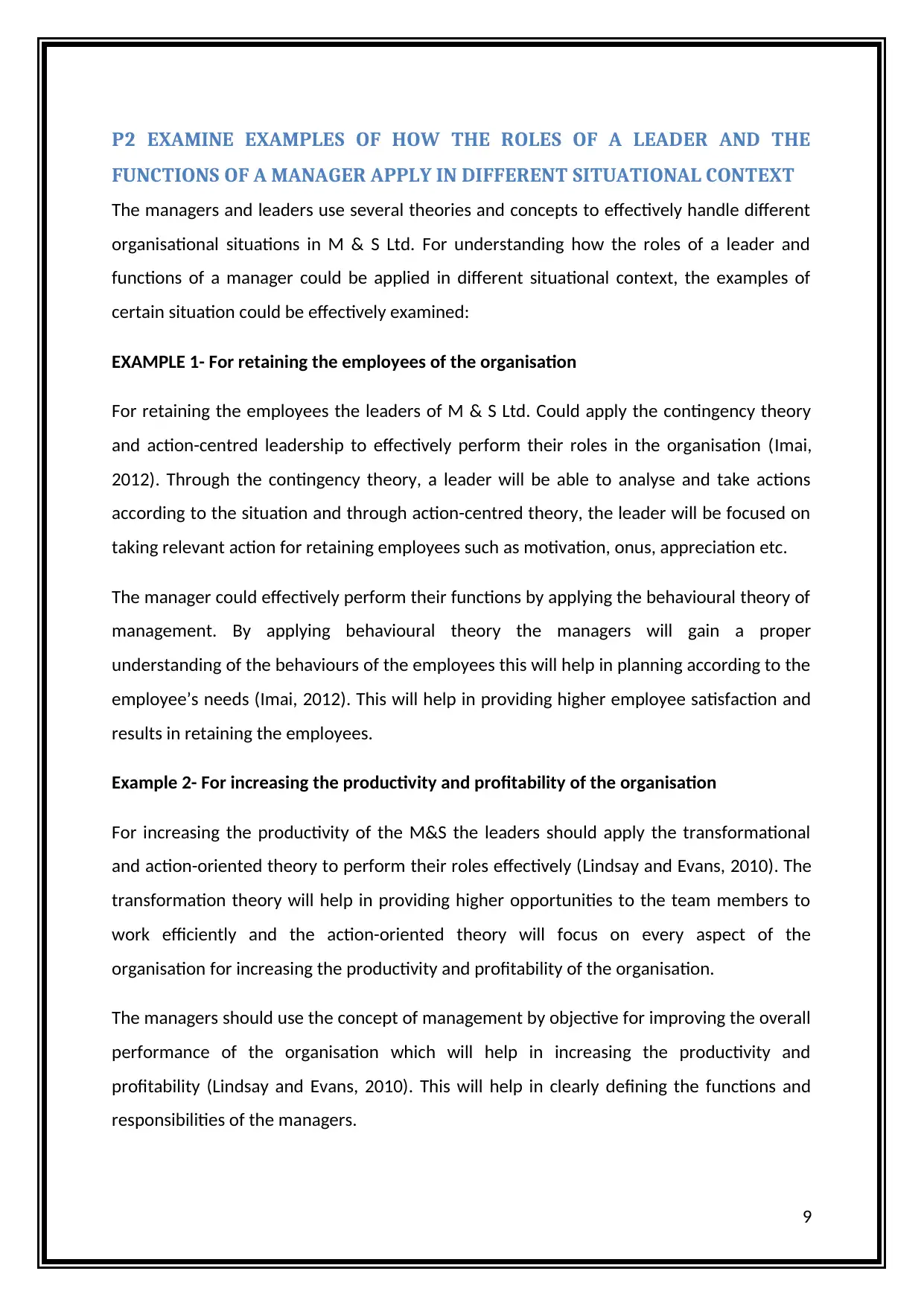
P2 EXAMINE EXAMPLES OF HOW THE ROLES OF A LEADER AND THE
FUNCTIONS OF A MANAGER APPLY IN DIFFERENT SITUATIONAL CONTEXT
The managers and leaders use several theories and concepts to effectively handle different
organisational situations in M & S Ltd. For understanding how the roles of a leader and
functions of a manager could be applied in different situational context, the examples of
certain situation could be effectively examined:
EXAMPLE 1- For retaining the employees of the organisation
For retaining the employees the leaders of M & S Ltd. Could apply the contingency theory
and action-centred leadership to effectively perform their roles in the organisation (Imai,
2012). Through the contingency theory, a leader will be able to analyse and take actions
according to the situation and through action-centred theory, the leader will be focused on
taking relevant action for retaining employees such as motivation, onus, appreciation etc.
The manager could effectively perform their functions by applying the behavioural theory of
management. By applying behavioural theory the managers will gain a proper
understanding of the behaviours of the employees this will help in planning according to the
employee’s needs (Imai, 2012). This will help in providing higher employee satisfaction and
results in retaining the employees.
Example 2- For increasing the productivity and profitability of the organisation
For increasing the productivity of the M&S the leaders should apply the transformational
and action-oriented theory to perform their roles effectively (Lindsay and Evans, 2010). The
transformation theory will help in providing higher opportunities to the team members to
work efficiently and the action-oriented theory will focus on every aspect of the
organisation for increasing the productivity and profitability of the organisation.
The managers should use the concept of management by objective for improving the overall
performance of the organisation which will help in increasing the productivity and
profitability (Lindsay and Evans, 2010). This will help in clearly defining the functions and
responsibilities of the managers.
9
FUNCTIONS OF A MANAGER APPLY IN DIFFERENT SITUATIONAL CONTEXT
The managers and leaders use several theories and concepts to effectively handle different
organisational situations in M & S Ltd. For understanding how the roles of a leader and
functions of a manager could be applied in different situational context, the examples of
certain situation could be effectively examined:
EXAMPLE 1- For retaining the employees of the organisation
For retaining the employees the leaders of M & S Ltd. Could apply the contingency theory
and action-centred leadership to effectively perform their roles in the organisation (Imai,
2012). Through the contingency theory, a leader will be able to analyse and take actions
according to the situation and through action-centred theory, the leader will be focused on
taking relevant action for retaining employees such as motivation, onus, appreciation etc.
The manager could effectively perform their functions by applying the behavioural theory of
management. By applying behavioural theory the managers will gain a proper
understanding of the behaviours of the employees this will help in planning according to the
employee’s needs (Imai, 2012). This will help in providing higher employee satisfaction and
results in retaining the employees.
Example 2- For increasing the productivity and profitability of the organisation
For increasing the productivity of the M&S the leaders should apply the transformational
and action-oriented theory to perform their roles effectively (Lindsay and Evans, 2010). The
transformation theory will help in providing higher opportunities to the team members to
work efficiently and the action-oriented theory will focus on every aspect of the
organisation for increasing the productivity and profitability of the organisation.
The managers should use the concept of management by objective for improving the overall
performance of the organisation which will help in increasing the productivity and
profitability (Lindsay and Evans, 2010). This will help in clearly defining the functions and
responsibilities of the managers.
9
⊘ This is a preview!⊘
Do you want full access?
Subscribe today to unlock all pages.

Trusted by 1+ million students worldwide
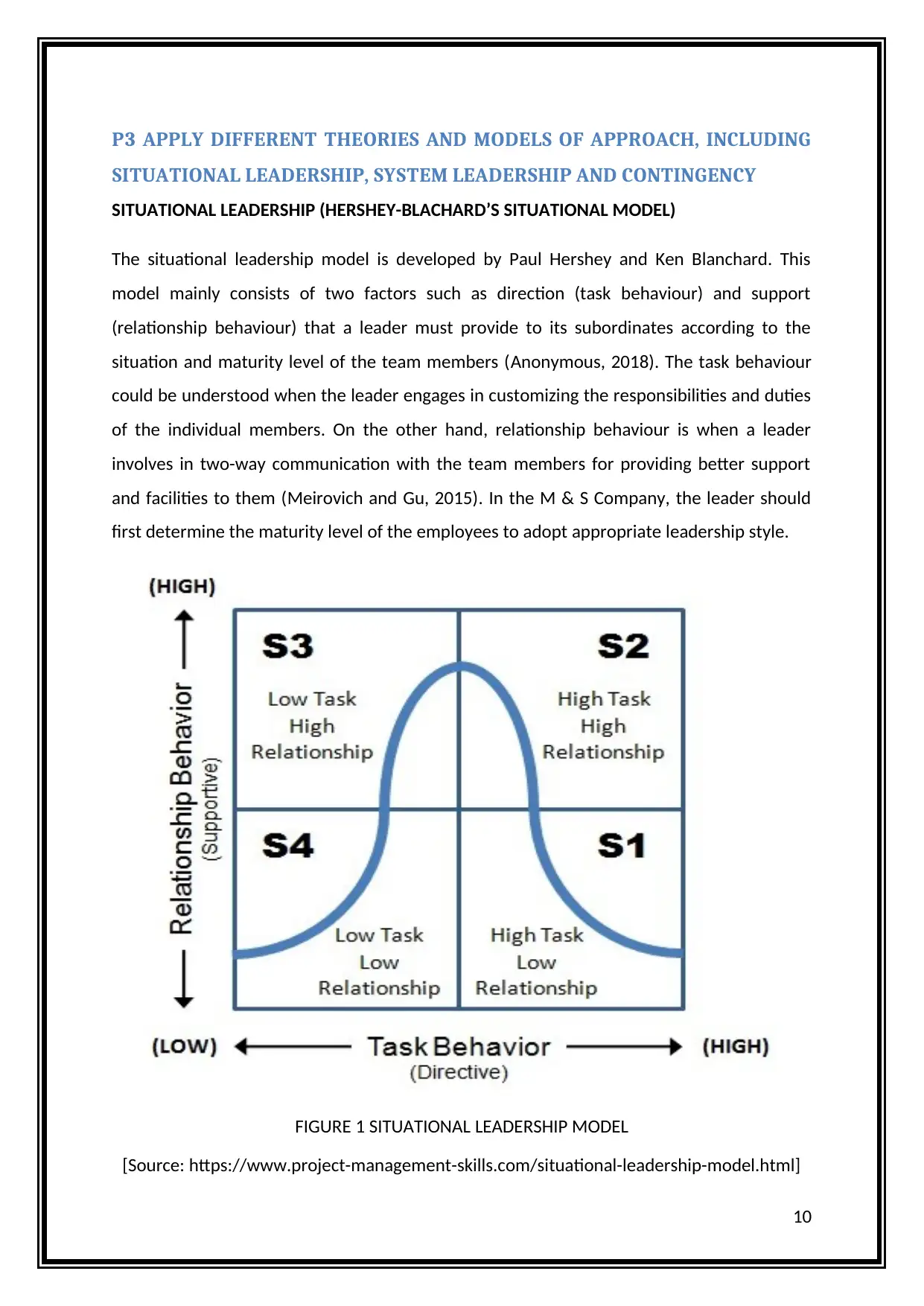
P3 APPLY DIFFERENT THEORIES AND MODELS OF APPROACH, INCLUDING
SITUATIONAL LEADERSHIP, SYSTEM LEADERSHIP AND CONTINGENCY
SITUATIONAL LEADERSHIP (HERSHEY-BLACHARD’S SITUATIONAL MODEL)
The situational leadership model is developed by Paul Hershey and Ken Blanchard. This
model mainly consists of two factors such as direction (task behaviour) and support
(relationship behaviour) that a leader must provide to its subordinates according to the
situation and maturity level of the team members (Anonymous, 2018). The task behaviour
could be understood when the leader engages in customizing the responsibilities and duties
of the individual members. On the other hand, relationship behaviour is when a leader
involves in two-way communication with the team members for providing better support
and facilities to them (Meirovich and Gu, 2015). In the M & S Company, the leader should
first determine the maturity level of the employees to adopt appropriate leadership style.
FIGURE 1 SITUATIONAL LEADERSHIP MODEL
[Source: https://www.project-management-skills.com/situational-leadership-model.html]
10
SITUATIONAL LEADERSHIP, SYSTEM LEADERSHIP AND CONTINGENCY
SITUATIONAL LEADERSHIP (HERSHEY-BLACHARD’S SITUATIONAL MODEL)
The situational leadership model is developed by Paul Hershey and Ken Blanchard. This
model mainly consists of two factors such as direction (task behaviour) and support
(relationship behaviour) that a leader must provide to its subordinates according to the
situation and maturity level of the team members (Anonymous, 2018). The task behaviour
could be understood when the leader engages in customizing the responsibilities and duties
of the individual members. On the other hand, relationship behaviour is when a leader
involves in two-way communication with the team members for providing better support
and facilities to them (Meirovich and Gu, 2015). In the M & S Company, the leader should
first determine the maturity level of the employees to adopt appropriate leadership style.
FIGURE 1 SITUATIONAL LEADERSHIP MODEL
[Source: https://www.project-management-skills.com/situational-leadership-model.html]
10
Paraphrase This Document
Need a fresh take? Get an instant paraphrase of this document with our AI Paraphraser
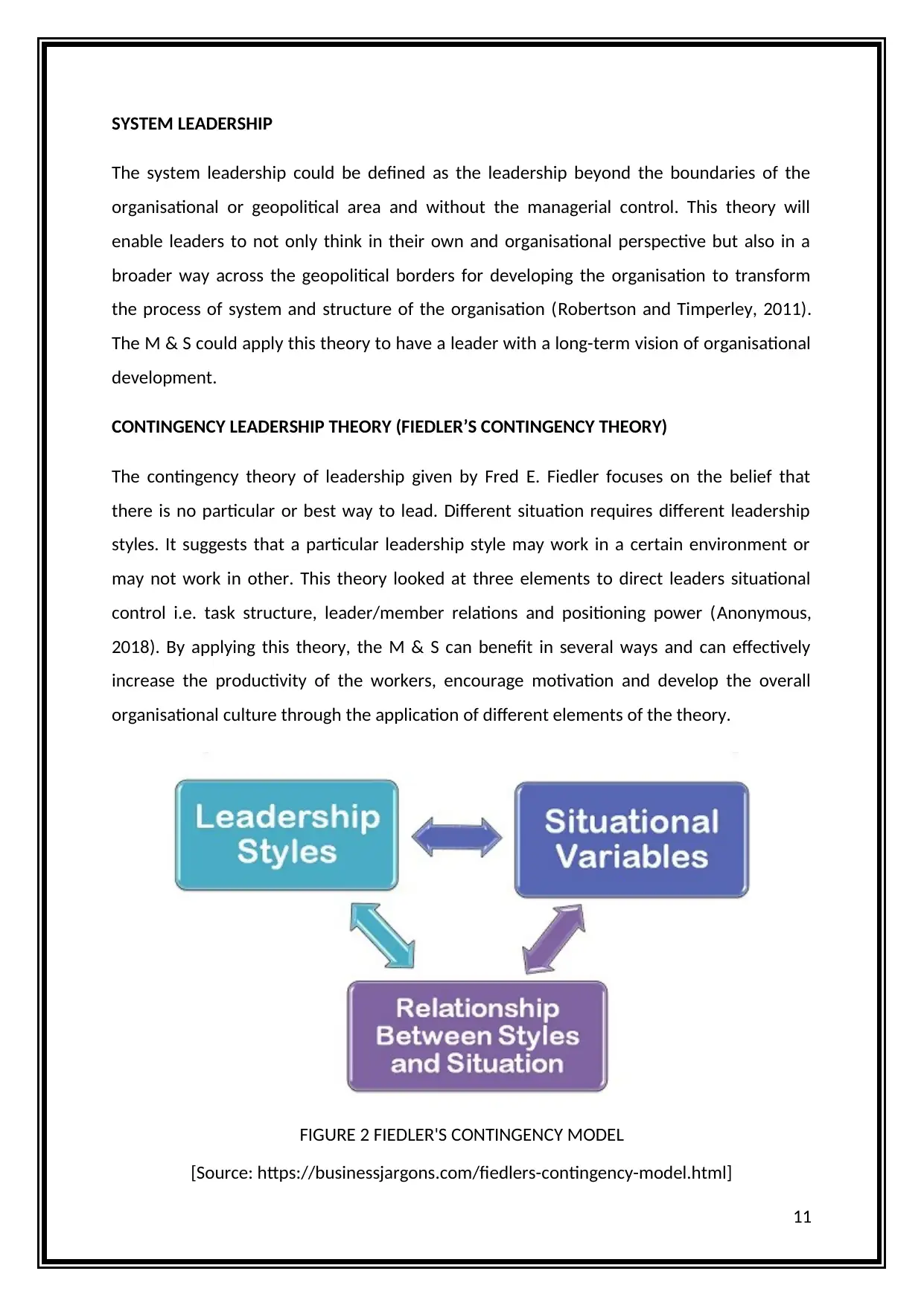
SYSTEM LEADERSHIP
The system leadership could be defined as the leadership beyond the boundaries of the
organisational or geopolitical area and without the managerial control. This theory will
enable leaders to not only think in their own and organisational perspective but also in a
broader way across the geopolitical borders for developing the organisation to transform
the process of system and structure of the organisation (Robertson and Timperley, 2011).
The M & S could apply this theory to have a leader with a long-term vision of organisational
development.
CONTINGENCY LEADERSHIP THEORY (FIEDLER’S CONTINGENCY THEORY)
The contingency theory of leadership given by Fred E. Fiedler focuses on the belief that
there is no particular or best way to lead. Different situation requires different leadership
styles. It suggests that a particular leadership style may work in a certain environment or
may not work in other. This theory looked at three elements to direct leaders situational
control i.e. task structure, leader/member relations and positioning power (Anonymous,
2018). By applying this theory, the M & S can benefit in several ways and can effectively
increase the productivity of the workers, encourage motivation and develop the overall
organisational culture through the application of different elements of the theory.
FIGURE 2 FIEDLER'S CONTINGENCY MODEL
[Source: https://businessjargons.com/fiedlers-contingency-model.html]
11
The system leadership could be defined as the leadership beyond the boundaries of the
organisational or geopolitical area and without the managerial control. This theory will
enable leaders to not only think in their own and organisational perspective but also in a
broader way across the geopolitical borders for developing the organisation to transform
the process of system and structure of the organisation (Robertson and Timperley, 2011).
The M & S could apply this theory to have a leader with a long-term vision of organisational
development.
CONTINGENCY LEADERSHIP THEORY (FIEDLER’S CONTINGENCY THEORY)
The contingency theory of leadership given by Fred E. Fiedler focuses on the belief that
there is no particular or best way to lead. Different situation requires different leadership
styles. It suggests that a particular leadership style may work in a certain environment or
may not work in other. This theory looked at three elements to direct leaders situational
control i.e. task structure, leader/member relations and positioning power (Anonymous,
2018). By applying this theory, the M & S can benefit in several ways and can effectively
increase the productivity of the workers, encourage motivation and develop the overall
organisational culture through the application of different elements of the theory.
FIGURE 2 FIEDLER'S CONTINGENCY MODEL
[Source: https://businessjargons.com/fiedlers-contingency-model.html]
11
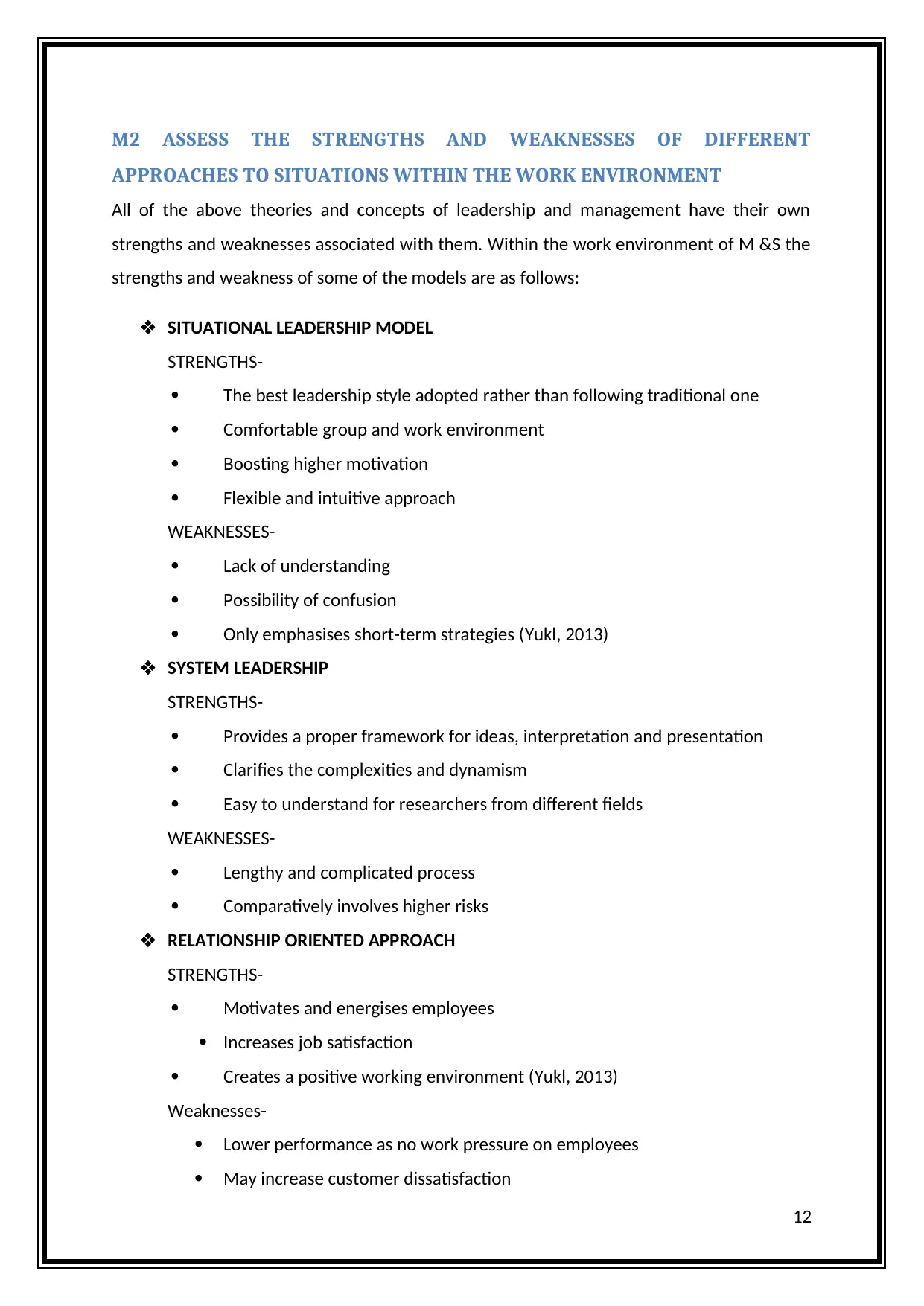
M2 ASSESS THE STRENGTHS AND WEAKNESSES OF DIFFERENT
APPROACHES TO SITUATIONS WITHIN THE WORK ENVIRONMENT
All of the above theories and concepts of leadership and management have their own
strengths and weaknesses associated with them. Within the work environment of M &S the
strengths and weakness of some of the models are as follows:
SITUATIONAL LEADERSHIP MODEL
STRENGTHS-
The best leadership style adopted rather than following traditional one
Comfortable group and work environment
Boosting higher motivation
Flexible and intuitive approach
WEAKNESSES-
Lack of understanding
Possibility of confusion
Only emphasises short-term strategies (Yukl, 2013)
SYSTEM LEADERSHIP
STRENGTHS-
Provides a proper framework for ideas, interpretation and presentation
Clarifies the complexities and dynamism
Easy to understand for researchers from different fields
WEAKNESSES-
Lengthy and complicated process
Comparatively involves higher risks
RELATIONSHIP ORIENTED APPROACH
STRENGTHS-
Motivates and energises employees
Increases job satisfaction
Creates a positive working environment (Yukl, 2013)
Weaknesses-
Lower performance as no work pressure on employees
May increase customer dissatisfaction
12
APPROACHES TO SITUATIONS WITHIN THE WORK ENVIRONMENT
All of the above theories and concepts of leadership and management have their own
strengths and weaknesses associated with them. Within the work environment of M &S the
strengths and weakness of some of the models are as follows:
SITUATIONAL LEADERSHIP MODEL
STRENGTHS-
The best leadership style adopted rather than following traditional one
Comfortable group and work environment
Boosting higher motivation
Flexible and intuitive approach
WEAKNESSES-
Lack of understanding
Possibility of confusion
Only emphasises short-term strategies (Yukl, 2013)
SYSTEM LEADERSHIP
STRENGTHS-
Provides a proper framework for ideas, interpretation and presentation
Clarifies the complexities and dynamism
Easy to understand for researchers from different fields
WEAKNESSES-
Lengthy and complicated process
Comparatively involves higher risks
RELATIONSHIP ORIENTED APPROACH
STRENGTHS-
Motivates and energises employees
Increases job satisfaction
Creates a positive working environment (Yukl, 2013)
Weaknesses-
Lower performance as no work pressure on employees
May increase customer dissatisfaction
12
⊘ This is a preview!⊘
Do you want full access?
Subscribe today to unlock all pages.

Trusted by 1+ million students worldwide
1 out of 26
Related Documents
Your All-in-One AI-Powered Toolkit for Academic Success.
+13062052269
info@desklib.com
Available 24*7 on WhatsApp / Email
![[object Object]](/_next/static/media/star-bottom.7253800d.svg)
Unlock your academic potential
Copyright © 2020–2025 A2Z Services. All Rights Reserved. Developed and managed by ZUCOL.





